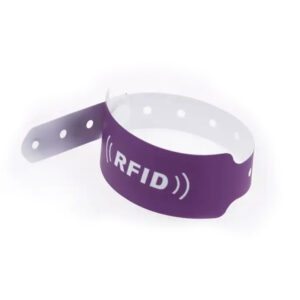Table of Contents
ToggleIntroduction
Radio Frequency Identification (RFID) technology is employed in a multitude of applications, including inventory management, asset tracking, access control, and payment systems. This technology enables accurate and efficient tracking of items, significantly reducing errors and improving operational efficiency. Within the healthcare sector, particularly in hospital wards, the application of medical wristband RFID tags is gaining rapid traction for its numerous benefits. This article explores the various uses of medical wristband RFID tags in hospital wards, their advantages, and how they revolutionize hospital operations.

Understanding Medical Wristband RFID Tags
Medical wristband RFID tags are typically equipped with an RFID chip that stores important patient identification information. This includes the patient’s name, medical record number, date of birth, and other essential details. The RFID chip communicates with an RFID reader, which is usually located at the patient’s bedside or on mobile carts used by nursing staff.
When a patient is admitted to the hospital, they are generally issued a wristband embedded with an RFID tag linked to their electronic medical record. This process ensures that all medical staff interacting with the patient can quickly and easily verify their identity, which is crucial during emergencies when decisions need to be made swiftly.
In addition to patient identification, medical wristband RFID tags are employed for several other purposes:
- Medication Administration Tracking: RFID tags can be used to monitor and track the administration of medication. This ensures that the correct patient receives the right medication at the accurate dosage and time, thus significantly reducing medication errors.
- Vital Signs Monitoring: These tags can assist in continuous monitoring of a patient’s vital signs, relaying real-time data to medical staff who can promptly respond to any critical changes.
- Inventory Management: RFID tags are also advantageous in managing hospital inventory, ensuring that essential supplies and equipment are adequately stocked and readily available when needed.
- Asset Tracking: Hospitals leverage RFID technology for tracking medical equipment such as infusion pumps and wheelchairs, ensuring their availability and timely maintenance.
In summary, medical wristband RFID tags are a valuable tool for enhancing patient safety and streamlining hospital workflows. However, to protect patient data and ensure appropriate use of this technology, hospitals must implement robust security measures.
Application of Medical Wristband RFID Tags in Hospital Wards
Upon a patient’s admission to a hospital ward, the attending nurse prints a wristband that contains crucial patient information such as the hospital department, bed number, name, gender, age, hospitalization number, diagnosis, and any known allergies. This wristband forms an essential part of the patient identification system that spans the entire duration of the patient’s hospital stay, from admission to discharge. The wristband is only removed and disposed of by the on-duty nurse once the patient is discharged.
During hospitalization, nurses utilize these identification wristbands to verify a patient’s identity before administering medications or intravenous therapy. This ensures that the treatment administered is appropriate for the patient, significantly reducing the risk of errors. Additionally, when the specimen collection department collects samples, staff no longer need to register patient details manually. By using information from the nursing station, they can instantly access all necessary data, making the specimen collection process fast and precise while minimizing human error.
For patients who are critically ill and may be unconscious, disoriented, or unable to communicate, medical staff can still accurately identify them through the use of the RFID wristbands. This enables healthcare providers to administer appropriate treatments promptly. Medical wristband RFID tags thus serve as advanced and reliable tools for standardized medical management. They effectively prevent medical accidents caused by patient misidentification and maximize management efficiency.
Ensuring Security and Privacy with RFID Technology
While the advantages of RFID technology in hospital wards are undeniable, it is paramount that hospitals implement robust security measures to protect patient data. Medical wristband RFID tags hold sensitive information that, if compromised, could lead to significant privacy concerns. Therefore, hospitals must employ encryption and secure access protocols to safeguard patient information.
Additionally, healthcare providers must be trained on the appropriate use of RFID technology to avoid misuse and ensure compliance with healthcare regulations. Regular audits and updates to the RFID system can further enhance security and ensure that patient data remains protected.
Integration with Hospital Information Systems
One of the significant benefits of RFID technology is its ability to integrate seamlessly with existing hospital information systems (HIS). This integration allows for real-time updates and access to patient records, enabling more efficient and coordinated care. For instance, RFID wristbands can automatically update a patient’s medical record with administered treatments, medication timings, and vital sign readings. This reduces the need for manual entry, minimizing the risk of errors and freeing up time for healthcare providers to focus on patient care.
Furthermore, the integration of RFID technology with HIS can improve overall hospital efficiency by providing valuable data analytics. Hospitals can gain insights into patient flow, resource utilization, and treatment outcomes, which can inform decision-making and enhance operational efficiency.
Conclusion
Medical wristband RFID tags have proven to be indispensable in hospital wards, offering comprehensive solutions for patient identification, medication tracking, vital sign monitoring, and asset management. These tags ensure swift and accurate patient verification, enhance patient safety, and optimize hospital workflows. However, to fully leverage the benefits of RFID technology, hospitals must implement stringent security measures to protect patient data and ensure its proper use. By adopting medical wristband RFID tags and integrating them with existing hospital information systems, healthcare facilities can significantly improve patient care, operational efficiency, and overall healthcare outcomes. Embracing this innovative technology is a crucial step towards a safer, more efficient healthcare environment.
